How to Make Gaeng Panang - Panang Curry
To make authentic Gaeng Panang, you’ll need panang curry paste, coconut milk, thinly sliced beef, and kaffir lime leaves. Toast your whole spices first, then blend them with fresh aromatics until smooth. Simmer the curry paste in coconut milk until thickened, add your protein, and finish with fish sauce and palm sugar for the perfect balance of flavors. This beloved Thai dish from the 18th century holds centuries of culinary wisdom waiting to be discovered.
Key Takeaways
- Toast whole spices in a dry skillet, then blend with fresh aromatics until smooth to create homemade curry paste.
- Simmer 2-3 tablespoons of panang curry paste in 2 cups coconut milk until thickened, avoiding boiling.
- Add thinly sliced beef and kaffir lime leaves, cooking until meat is tender and fully cooked.
- Season with fish sauce and palm sugar to balance saltiness and sweetness to taste.
- Finish with thick coconut cream and additional kaffir lime leaves for authentic flavor and presentation.
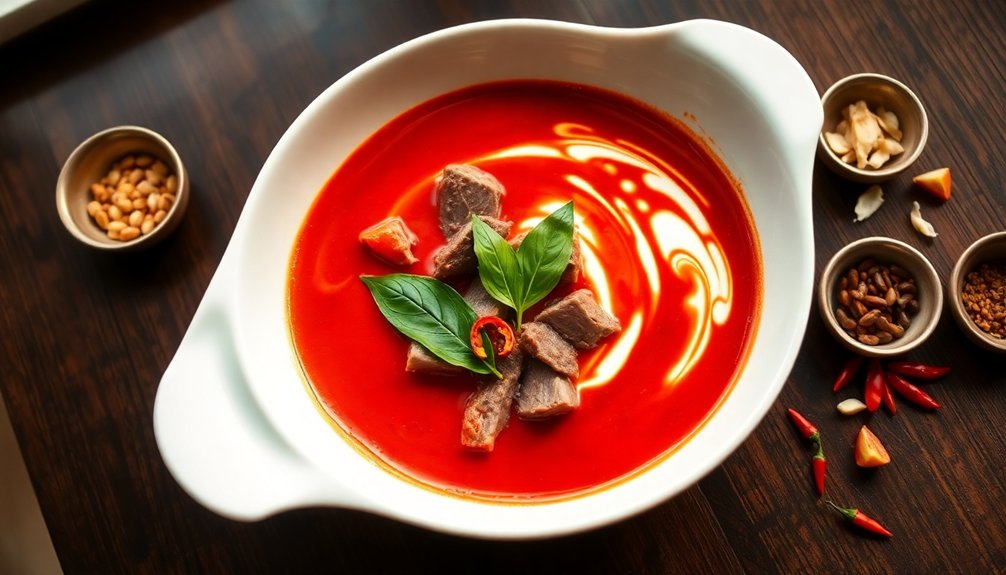
History
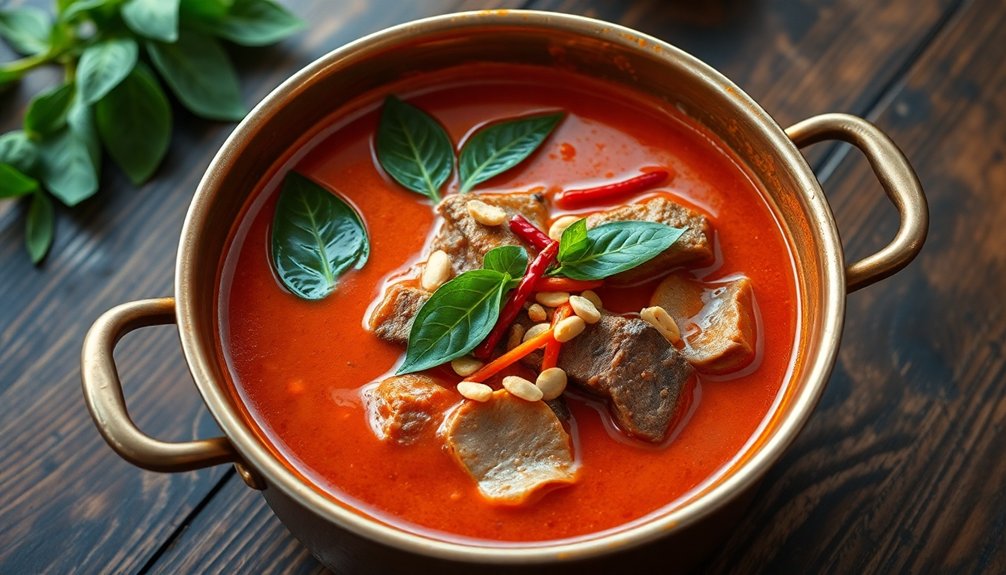
Although the exact origins of Gaeng Panang remain debated, this rich curry emerged from Thailand’s central plains during the early Rattanakosin period of the late 18th century.
You’ll find its Thai origins deeply rooted in the Muslim communities that influenced the region’s culinary landscape during this era.
The curry’s evolution reflects a fascinating blend of Thai and Malaysian cooking traditions, resulting in a distinctively drier and more concentrated curry compared to other Thai varieties.
Its name likely derives from the Malaysian city of Penang, though it’s developed its own unique identity in Thai cuisine.
The recipe has been refined over generations, maintaining its core elements while adapting to local ingredients and tastes.
Today’s version features the signature coconut cream-based sauce that’s become synonymous with authentic Panang curry.
Recipe
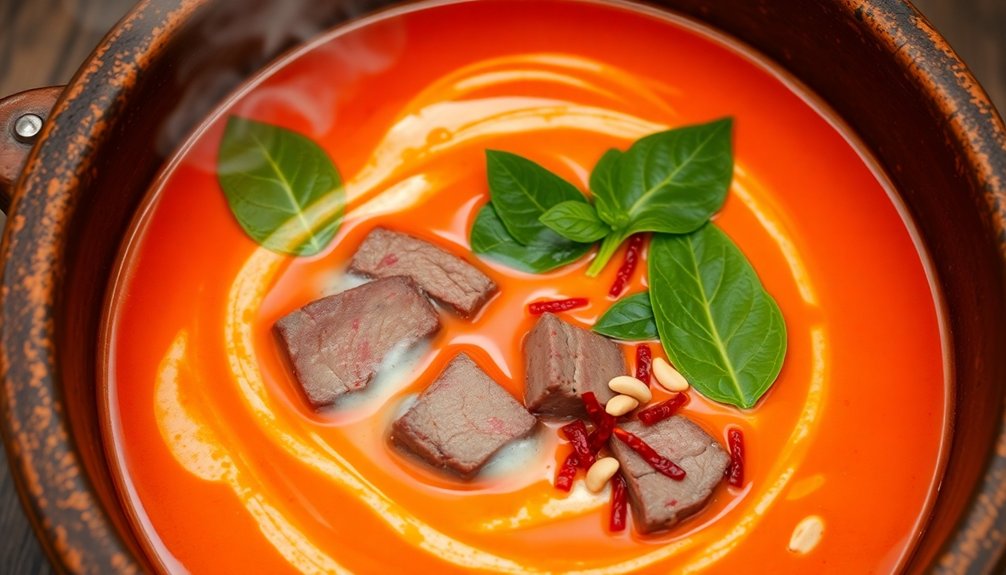
Ingredients
- 2-3 tablespoons panang curry paste
- 2 cups coconut milk
- 1 pound beef, sliced thinly
- 4-5 kaffir lime leaves, thinly sliced
- 2-3 tablespoons fish sauce
- 2-3 tablespoons palm sugar
- 1/2 cup Thai basil leaves
- 2-3 red chilies, sliced
- 1/4 cup peanuts, crushed
Instructions:
- Heat thick coconut cream in a wok over medium heat until oil separates.
- Add curry paste and fry until fragrant, about 2-3 minutes.
- Add beef and stir to coat with curry paste.
- Pour in remaining coconut milk and bring to a simmer.
- Add kaffir lime leaves, fish sauce, and palm sugar.
- Simmer until beef is tender and sauce thickens, about 15-20 minutes.
- Taste and adjust seasoning if needed.
- Add Thai basil leaves.
- Transfer to serving bowl.
- Garnish with sliced chilies and crushed peanuts.
- Serve hot with steamed rice.
Cooking Steps
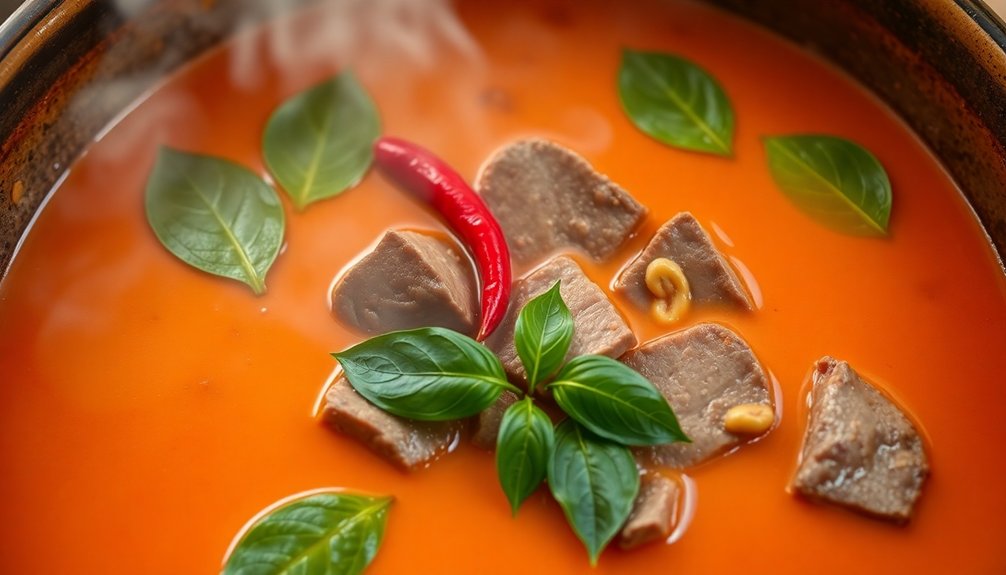
Begin your Gaeng Panang by dry-toasting the whole spices in a skillet until they release their essential oils and become intensely aromatic.
Next, you’ll blend the toasted spices with fresh aromatics until they form a smooth, uniform paste that’s free of any fibrous bits.
Finally, simmer your curry paste in coconut milk until it thickens, then enrich it with coconut cream before adding your choice of protein and finishing with traditional Thai garnishes like makrut lime leaves and red chilies.
Step 1. Toast Spices Until Fragrant
To develop the complex flavors characteristic of authentic Panang curry, you’ll first need to toast the raw spices in a dry skillet over medium heat.
Start with whole coriander seeds, cumin seeds, white peppercorns, and cardamom pods, spreading them evenly across the pan’s surface.
Keep the spices moving constantly to prevent burning, shaking the pan or stirring with a wooden spoon.
You’ll notice the spices becoming intensely aromatic after 2-3 minutes, releasing their essential oils.
Watch for the coriander to turn slightly golden and the cumin to darken a shade.
Once you detect a rich, nutty fragrance and the spices have darkened slightly, immediately transfer them to a cool plate to prevent overcooking.
This aroma enhancement step is vital for achieving the curry’s signature depth.
Step 2. Blend Paste Until Smooth
Grinding the toasted spices with fresh aromatics creates the vibrant foundation of Panang curry paste. Transfer your toasted spices to a mortar and pestle, then add fresh lemongrass, galangal, kaffir lime leaves, and shallots. Pound these ingredients together until they begin breaking down into a coarse mixture.
Now add the soaked dried chilies, garlic cloves, and shrimp paste to your mortar. Continue grinding with steady, circular motions until you achieve a smooth, uniform consistency.
If you’re using a food processor instead, pulse the ingredients in short bursts, scraping down the sides frequently. You’ll know your curry paste is ready when it’s deeply aromatic and has a thick, velvety texture without any visible chunks or fibers.
Step 3. Simmer Curry Until Thickened
Once your curry paste is ready, heat coconut cream in a large wok or heavy-bottomed pot over medium heat until it starts to split and release its oils.
Add your homemade curry paste and fry it for 3-4 minutes, stirring constantly to prevent burning while the aromatics bloom and intensify.
Pour in the remaining coconut milk and bring the mixture to a gentle simmer.
Add your meat of choice and kaffir lime leaves, then reduce heat to medium-low.
Let the curry simmer uncovered for 15-20 minutes, allowing the sauce to thicken naturally.
You’ll know it’s ready when the oils begin to surface and the meat is tender.
Taste and adjust the flavor balance by adding palm sugar for sweetness or fish sauce for saltiness.
The finished curry should coat the back of a spoon with a rich, velvety consistency.
Step 4. Add Coconut Cream
As your curry reaches its ideal thickness, you’ll notice the vibrant oils beginning to surface – now’s the perfect moment to add the final touch of coconut cream.
Pour in about 1/2 cup of thick coconut cream, stirring gently to incorporate it into the curry without breaking the luxurious oils that have developed.
The coconut cream benefits your Gaeng Panang in multiple ways, enhancing flavors while creating a silky, rich texture that’s characteristic of authentic Thai curries.
You’ll want to let it simmer for just 1-2 minutes more, allowing the cream to blend seamlessly with the spices.
The natural sweetness of the coconut cream balances the curry’s heat and adds that signature velvety finish that makes Panang curry so distinctive among Thai dishes.
Step 5. Add Protein and Garnishes
The traditional protein choice for Gaeng Panang is thinly sliced beef, though you’ll also find variations using chicken, pork, or even duck in modern Thai kitchens.
For beef, select tender cuts like sirloin or ribeye, slicing them against the grain into thin strips that’ll cook quickly and remain tender.
If you’re preparing a vegetarian version, firm tofu options work well – just be sure to press and pan-fry the tofu first to improve its texture.
Once you’ve added your chosen protein to the curry, let it simmer until fully cooked.
Finish the dish by garnishing with fresh kaffir lime leaves cut into fine ribbons, a sprinkle of Thai basil leaves, and thinly sliced red chilies.
These garnishes aren’t just decorative – they’re essential for achieving the curry’s authentic aroma and taste.
Cooking Tips
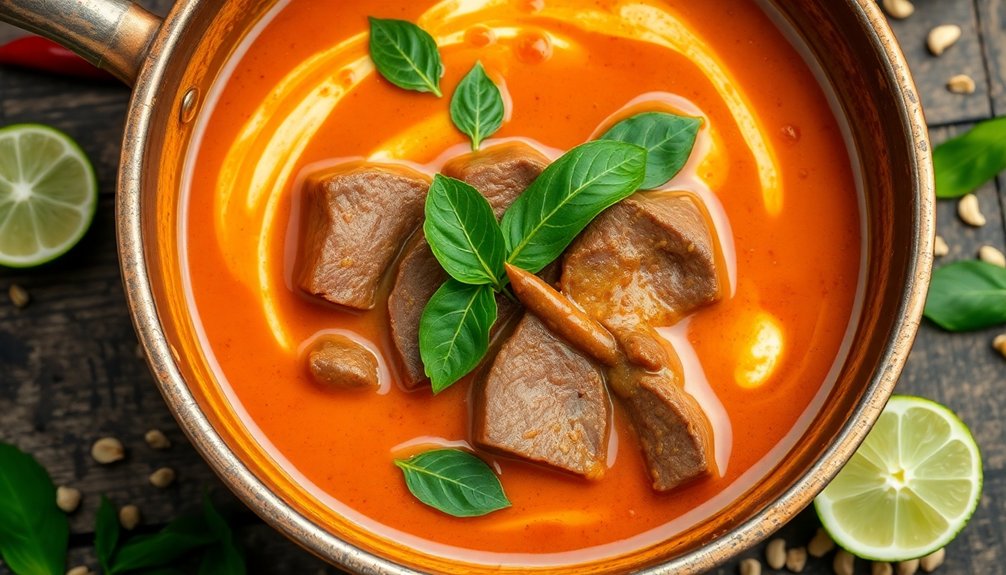
When preparing Gaeng Panang, maintaining consistent heat throughout the cooking process is essential for properly developing the curry’s complex flavors.
You’ll want to keep the curry at a gentle simmer, never allowing it to reach a rolling boil, which can break down the coconut milk and create a grainy texture.
If you can’t find certain ingredients, there are acceptable substitutions. You can use regular lime juice instead of kaffir lime leaves, though you’ll lose some authentic aroma.
For galangal, ginger can work in a pinch, but use less as it’s more pungent.
When cooking, you’ll achieve better results by adding your curry paste to the thick coconut cream first, letting it “crack” and release its oils before introducing additional liquids.
This traditional cooking technique helps intensify the curry’s signature flavors.
Final Thoughts
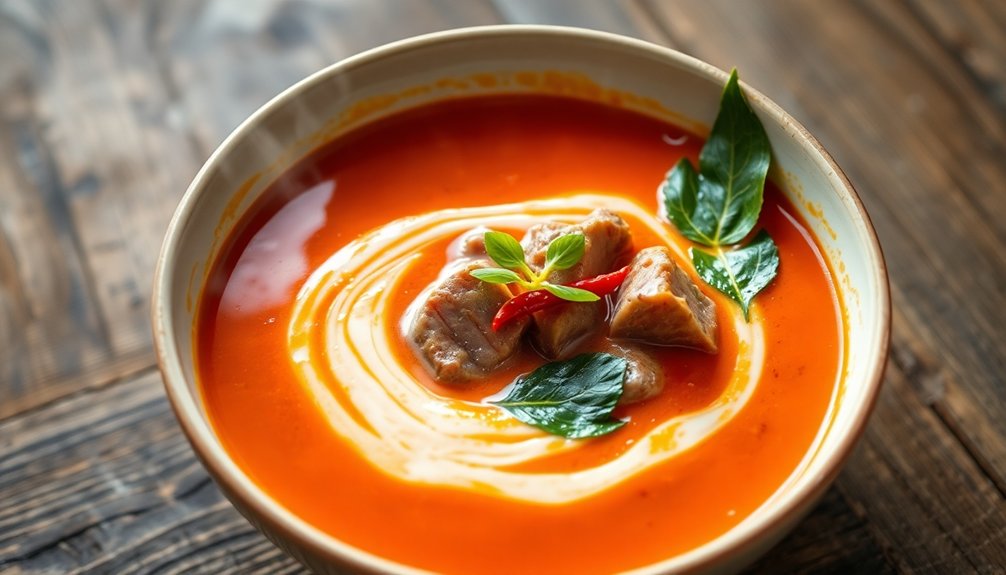
Making authentic Gaeng Panang requires patience and attention to detail, but you’ll find the results deeply rewarding. Your cooking experiences will evolve as you master this classic Thai curry, allowing you to explore flavor variations while maintaining its traditional essence.
- The rich aroma of freshly ground spices will transport you to the bustling streets of Thailand.
- The satisfaction of creating your own curry paste connects you to centuries of culinary tradition.
- The vibrant colors of the finished dish will make your heart swell with pride.
- The first taste will remind you why homemade curry surpasses any restaurant version.
- The joy of sharing this authentic dish with loved ones creates lasting memories.
Master this recipe, and you’ll always have a piece of Thai culinary heritage at your fingertips.
Frequently Asked Questions
Can I Substitute Coconut Milk With Regular Milk in Panang Curry?
You shouldn’t substitute regular milk for coconut milk in Panang curry. For authentic flavors, use coconut milk alternatives like cashew cream or dairy-free coconut-based creams to maintain the curry’s traditional richness.
How Long Can Leftover Panang Curry Be Stored in the Refrigerator?
Isn’t it funny how we worry about curry shelf life when it rarely lasts past dinner? You can safely store your leftover panang curry in an airtight container for 3-4 days in the fridge.
Is Panang Curry Always Spicier Than Red or Green Thai Curry?
You’ll find that spice levels vary, but Panang curry typically isn’t the spiciest. While it shares flavor profiles with red curry, it’s generally milder and richer with a distinct nutty sweetness.
What’s the Difference Between Panang Curry Paste and Massaman Curry Paste?
Like distant cousins at a family reunion, these pastes differ distinctly. You’ll find Panang’s brighter flavor profile with peanuts and kaffir lime, while Massaman’s earthier blend features warm spices like cinnamon and cardamom.
Why Does My Panang Curry Taste Bitter and How Can I Fix It?
If your curry’s bitter, you’re likely burning the paste or using too much kaffir lime. Try balancing flavors by adding palm sugar and coconut milk, while sautéing paste more gently.
